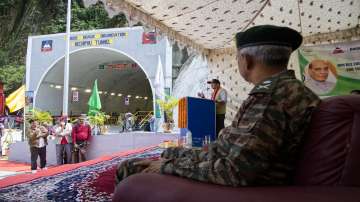Defence Minister Rajnath Singh on Tuesday virtually inaugurated a strategically located Nechiphu tunnel connecting Arunachal Pradesh's Tawang with Assam's Balipara. The tunnel will bypass the Nechiphu Pass, where extreme foggy conditions prevail, causing hindrance to general traffic and military convoys.
Arunachal Pradesh Chief Minister Pema Khandu termed the tunnel an "architectural masterpiece", and said that the strategically located tunnel will facilitate the swift movement of troops as well as citizens. "Cutting a short distance by about 5 km, the tunnel will provide ease of travel and connectivity in the stretch that has dense fog," Khandu wrote on X (formerly known as Twitter).
The newly-built 500-metre Nechiphu tunnel is being termed strategically crucial for the Armed Forces as it will provide all-weather connectivity to the strategic Tawang region along the Line of Actual Control. The tunnel is a part of the Center's immense infrastructure drive in the area amid the border tension with China and will be useful to both the military and tourism.
Some key features of strategically important Nechiphu tunnel
- The Nechiphu tunnel has been built at an altitude of 5,600 feet on the Balipara-Charduar-Tawang road in Arnacha's Kameng district
- The tunnel will provide all-weather connectivity to the strategic Tawang Region
- The tunnel has been constructed under 'Project Vartak' of Border Road Organisation
- It will reduce the travel distance of military vehicles transiting towards the Indo-China border by 6 km
- The tunnel facilitates the movement of all types of military vehicles including the artilleries
- Tunnel conceived to bypass extreme foggy conditions prevailing near Nachipu pass
- Earlier, the region's thick fog interfered with military and civilian movement. Such visual difficulties would be countered by the tunnel
- The tunnel features automatic lighting and monitoring systems that are controlled by supervisory control and data acquisition
- The tunnel is designed for two-way traffic and incorporates contemporary lighting and safety features
How the tunnel was constructed?
It should be mentioned here that the construction of the tunnel is being accomplished by cutting through fragile Himalayan mountains with highly fractured rock under low overburden. The same is being tackled on a daily basis through strict 3D monitoring and through the proactive application of the desired tunnel support system. The new Austrian Tunnelling method is being used to achieve construction at a fast pace. The tunnel will be provided with an electro-mechanical system including firefighting devices, an auto illumination system and SCADA-controlled monitoring systems.
Notably, this is one of the many tunnels conceived by the Border Roads Organization along Border areas to improve existing road geometrics, avoid foggy areas, circumvent slide-prone areas and reduce black spots on the roads to offer greater safety to the Military and civil traffic movement.
ALSO READ: Rajnath Singh inaugurates 90 infra projects, including Arunachal's Nechiphu Tunnel, J&K's Devak bridge
